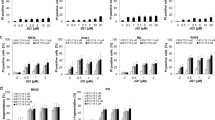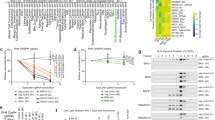Abstract
The aberrant expression of the transcription factors PAX3 and PAX3/FKHR associated with rhabdomyosarcoma (RMS), solid tumors displaying muscle cell features, suggests that these proteins play an important role in the pathogenesis of RMS. We could previously demonstrate that one of the oncogenic functions of PAX3 and PAX3/FKHR in RMS is protection from apoptosis. BCL-XL is a prominent anti-apoptotic protein present in normal skeletal muscle and RMS cells. In the present study, we establish that BCL-XL is transcriptionally modulated by PAX3 and PAX3/FKHR, since enhanced expression of both PAX proteins stimulates transcription of endogenous BCL-XL mRNA in a cell type specific manner. Further, we present evidence that both PAX3 and PAX3/FKHR can transcriptionally activate the Bcl-x gene promoter in cotransfection assays. Using electrophoretic mobility shift assays, an ATTA binding site for PAX3 and PAX3/FKHR could be localized in the upstream promoter region (position −42 to −39). Finally, ectopic overexpression of either PAX3, PAX3/FKHR or BCL-XL can rescue tumor cells from apoptosis induced by antisense treatment. These results suggest that at least part of the anti-apoptotic effect of PAX3 and PAX3/FKHR is mediated through direct transcriptional modulation of the prominent anti-apoptotic protein BCL-XL.
This is a preview of subscription content, access via your institution
Access options
Subscribe to this journal
Receive 50 print issues and online access
$259.00 per year
only $5.18 per issue
Buy this article
- Purchase on Springer Link
- Instant access to full article PDF
Prices may be subject to local taxes which are calculated during checkout





Similar content being viewed by others
References
Adams B, Dorfler P, Aguzzi A, Kozmik Z, Urbanek P, Maurerfogy I and Busslinger M . 1992 Genes Dev 6: 1589–1607
Adams JM and Cory S . 1998 Science 281: 1322–1326
Anderson MJ, Viars CS, Czekay S, Cavenee WK and Arden KC . 1998 Genomics 47: 187–199
Bennicelli JL, Edwards RH and Barr FG . 1996 Proc Natl Acad Sci USA 93: 5455–5459
Bernasconi M, Remppis A, Fredericks WJ, Rauscher III FJ and Schäfer BW . 1996 Proc Natl Acad Sci USA 63: 13164–13169
Borycki AG, Li J, Jin F, Emerson CP and Epstein JA . 1999 Development 126: 1665–1674
Burri M, Tromvoukis Y, Bopp D, Frigerio G and Noll M . 1989 EMBO J 8: 1183–1190
Chalepakis G, Jones FS, Edelman GM and Gruss P . 1994 Proc Natl Acad Sci USA 91: 12745–12749
Dahl E, Koseki H and Balling R . 1997 BioEssays 19: 755–765
Daston G, Lamar E, Olivier M and Goulding M . 1996 Development 122: 1017–1027
Davis RJ, D'Cruz CM, Lovell MA, Biegel JA and Barr FG . 1994 Cancer Res 54: 2869–2872
Del Peso L, Gonzalez VM, Hernandez R, Barr FG and Nunez G . 1999 Oncogene 18: 7328–7333
Dibbert B, Daigle I, Braun D, Schranz C, Weber M, Blaser K, Zangemeister-Wittke U, Akbar AN and Simon HU . 1998 Blood 92: 778–783
Epstein JA, Lam P, Jepeal L, Maas RL and Shapiro DN . 1995 J Biol Chem 270: 11719–11722
Epstein JA, Shapiro DN, Cheng J, Lam PYP and Maas RL . 1996 Proc Natl Acad Sci USA 93: 4213–4218
Franz T . 1993 Anat Embryol 187: 371–377
Frascella E, Toffolatti L and Rosolen A . 1998 Cancer Genet Cytogenet 102: 104–109
Fredericks WJ, Galili N, Mukhopadhyay S, Rovera G, Bennicelli J, Barr FG and Rauscher III FJ . 1995 Mol Cell Biol 15: 1522–1535
Galili N, Davis RJ, Fredericks WJ, Mukhopadhyay S, Rauscher III FJ, Emanuel BS, Rovera G and Barr GF . 1993 Nature Genet 5: 230–235
Ginsberg JP, Davis RJ, Bennicelli JL, Nauta LE and Barr FG . 1998 Cancer Res 58: 3542–3546
Goulding M, Lumsden A and Paquette AJ . 1994 Development 120: 957–971
Goulding MD, Chalepakis G, Deutsch U, Erselius JR and Gruss P . 1991 EMBO J 10: 1135–1147
Hollenbach AD, Sublett JE, McPherson CJ and Grosveld G . 1999 EMBO J 18: 3702–3711
Lam PY, Sublett JE, Hollenbach AD and Roussel MF . 1999 Mol Cell Biol 19: 594–601
Mansouri A, Hallonet M and Gruss P . 1996 Curr Opin Cell Biol 8: 851–857
Maroto M, Reshef R, Munsterberg AE, Koester S, Goulding M and Lassar AB . 1997 Cell 89: 139–148
Maulbecker CC and Gruss P . 1993 EMBO J 12: 2361–2367
Morgenstern JP and Land H . 1990 Nucleic Acids Res 18: 3587–3596
Motoyama N, Wang F, Roth KA, Sawa H, Nakayama K, Negishi I, Senju S, Zhang Q, Fujii S et al. 1995 Science 267: 1506–1510
Naik P, Karrim J and Hanahan D . 1996 Genes Dev 10: 2105–2116
Nutt SL, Morrison AM, Dorfler P, Rolink A and Busslinger M . 1998 EMBO J 17: 2319–2333
Phelan SA, Ito M and Loeken MR . 1997 Diabetes 46: 1189–1197
Schäfer BW . 1998 Gen Physiol Biophys 17: 1–14
Schäfer BW, Czerny T, Bernasconi M, Genini M and Busslinger M . 1994 Nucleic Acids Res 22: 4574–4582
Scheidler S, Fredericks WJ, Rauscher FJ, Barr FG and Vogt PK . 1996 Proc Natl Acad Sci USA 93: 9805–9809
Schreiber E, Matthias P, Muller MM and Schaffner W . 1989 Nucleic Acids Res 17: 6419
Tajbakhsh S, Rocancourt D, Cossu G and Buckingham M . 1997 Cell 89: 127–138
Tapscott SJ, Mathew JT and Weintraub H . 1993 Science 259: 1450–1453
Wang W, Kumar P, Wang W, Epstein J, Helman L, Moore JV and Kumar S . 1998 Cancer Res 58: 4426–4433
Watanabe A, Takeda K, Ploplis B and Tachibana M . 1998 Nat Genet 18: 283–286
Wiggan O, Taniguchisidle A and Hamel PA . 1998 Oncogene 16: 227–236
Wilson D, Sheng G, Lecuit T, Dostatni N and Desplan C . 1993 Genes Dev 7: 2120–2134
Acknowledgements
We thank Dr P Houghton for the generous gift of Rh1 and Rh30 cells, Drs L Boise and A Himmelmann for providing the cDNAs coding for BCL-XL and PAX5, respectively, and Patricia McLoughlin for critical reading of the manuscript. We are especially grateful to Dr U Zangemeister-Wittke for providing the BCL-XL antisense oligonucleotides. Additionally, we thank Omar Murmann for his expert technical assistance with cotranfection studies and electrophoretic mobility shift assays. Prof Dr K Winterhalter and CW Heizmann are acknowledged for their continuous support of this project. The work was supported by grants from the Swiss National Science Foundation (31-46886.96 and 31-56869.99) and the Stiftung für wissenschaftliche Forschung of the University of Zürich.
Author information
Authors and Affiliations
Rights and permissions
About this article
Cite this article
Margue, C., Bernasconi, M., Barr, F. et al. Transcriptional modulation of the anti-apoptotic protein BCL-XL by the paired box transcription factors PAX3 and PAX3/FKHR. Oncogene 19, 2921–2929 (2000). https://doi.org/10.1038/sj.onc.1203607
Received:
Revised:
Accepted:
Published:
Issue Date:
DOI: https://doi.org/10.1038/sj.onc.1203607
Keywords
This article is cited by
-
MEK and MCL-1 sequential inhibition synergize to enhance rhabdomyosarcoma treatment
Cell Death Discovery (2022)
-
The PAX3-FOXO1 oncogene alters exosome miRNA content and leads to paracrine effects mediated by exosomal miR-486
Scientific Reports (2019)
-
Obatoclax (GX15-070) triggers necroptosis by promoting the assembly of the necrosome on autophagosomal membranes
Cell Death & Differentiation (2013)
-
Cell lineage and cell death: Caenorhabditis elegans and cancer research
Nature Reviews Cancer (2011)
-
PAX3 expression in primary melanomas and nevi
Modern Pathology (2008)



